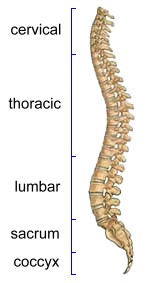The Spine The spinal column is a series of about 33 connected bones called vertebrae that stretch from the skull all the way down to the pelvis. Vertebrae are connected to one another by joints that allow them to move relative to one another. Between every pair of vertebrae is a disc of cartilage that help absorb shock (for example, from walking), and keep the bones from rubbing against one another.
The spinal column is a series of about 33 connected bones called vertebrae that stretch from the skull all the way down to the pelvis. Vertebrae are connected to one another by joints that allow them to move relative to one another. Between every pair of vertebrae is a disc of cartilage that help absorb shock (for example, from walking), and keep the bones from rubbing against one another.This alternating stack of bone and cartilage helps protect the nervous system's spinal cord, a bundle of nerves which connect the entire body to the brain, and which runs up through the centre of the spine. As you can see from the diagram at the right, the spine is naturally curved; the curves help to distribute mechanical stress as the body moves. The spine also has different regions, based on what part of the body it is in. The cervical vertebrae form the neck. The thoracic vertebrae are in the upper back, and contain the connections to the ribs. The lumbar vertebrae are centred in the lower back, and are the largest, since they carry most of the body's weight. The sacrum and coccyx (tail bone) form the bottom of the spine. The vertebrae of the spine are held together by two thick ligaments that run the entire length of the spine, and by smaller ligaments between each pair of vertebrae. Several sets of muscles are also attached to the vertebrae, which help to both support the spine and allow it to move. |